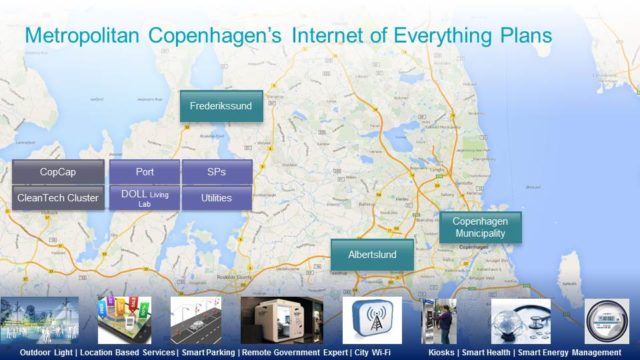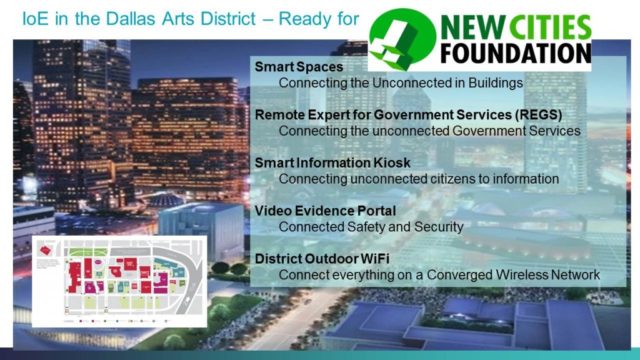The Future of Cities Is Now
June 1, 2014 — Blog
As cities and communities prepare for the future, they must confront a tsunami of challenges that can overwhelm how people live, work, play and learn. For the first time, more than half the world now lives in cities, and the influx is growing faster than many cities can accommodate.
One element that will define the future of cities is what we call “Internet of Everything” – or IoE for short. We define the Internet of Everything (IoE) as bringing together people, processes, data, and things to make networked connections more relevant and valuable than ever before.
Today, about 500 million urban dwellers live in poverty, without access to healthcare or education. The world population will swell about 50% to more than 9 billion in the next few decades, placing huge strains on energy and food resources, jobs, transportation and more. The population in many mature cities continues to shrink while it’s booming in developing economies, triggering seismic demographic shifts worldwide.

The 21st Century is the Century of Urbanization
Indeed, the 21st century is shaping up to be the century of urbanization, and competition will be more between cities – not countries. That’s why it’s increasingly important for all of us to foster more sustainable communities for our children – economically, socially and environmentally.
On June 18, I had the privilege of hosting a media roundtable at the NewCities Summit held this year in Dallas, Texas, to share insights with urban officials and experts about innovative solutions they are implementing to address many of these challenges. They have turned to “connecting the unconnected” through the power of the Internet of Everything to deliver more effective urban services. IoE is improving everything from education and public safety to parking and even more direct and democratic exchanges between government and citizens.
At Cisco, we have identified $3 trillion of economic value that can be realized by cities alone over the next decade by leveraging sensors, applications and data analytics linked to the Internet through a common platform.
Here are some highlights of our media roundtable at the NewCities Summit:
Midland County, Texas, Library:
In Midland, Texas, officials struggled with declining visitors, especially young students, at the county library, composed of an old building where technology was an afterthought. By converging new digital and physical architectures at the outset, they completely rebuilt the structure into one that’s the envy of libraries everywhere. This resulted in a 1,000% increase in materials circulated and 100% increase in traffic, stated Jason Bates, Midland County, Texas, Library’s IT director; and John Trischitte, the director of Midland County, Texas, Public Libraries.
City of Copenhagen: Outdoor Living Lab
In Copenhagen, already recognized as one of the world’s most innovative and livable cities, officials are determined to push for even greater urban services to attract young talent, ensure plenty of jobs, become more vibrant and especially to be carbon neutral by 2025. By planning for a citywide digital infrastructure, the greater municipality of Copenhagen recently announced new agreements that will help them to deliver smart lighting, parking kiosks and other digital solutions to control energy consumption.
Joining the session by Cisco TelePresence from Copenhagen was Niels Carsten Bluhme, director in the Municipality of Albertslund (Copenhagen Metropolitan Area). Niels talked about his district’s “outdoor living lab” with open protocols tied to a single network, to test and evaluate smart lighting solutions from numerous providers in a competitive environment. The outdoor living lab will serve as a testing ground to determine the best solution to control outdoor lighting when needed to conserve energy and protect citizens.

City of Dallas: a Model for IoE
To properly prepare for the future, the City of Dallas is rapidly becoming a model for using the Internet of Everything to reduce crime, enhance interactions with citizens and provide key information – via the convenience of a smart phone.
Shawn Williams, the public information officer for Dallas, discussed new Smart City solutions that address technology, architecture, public safety, economic vitality, and the arts and culture of the city. For example, the city’s open data portal makes it easy for application developers to create apps relevant to their own neighborhoods or areas of interest. Video cameras mounted in high-crime areas help public safety officers monitor and respond to incidents; outdoor Wi-Fi linked to informative and interactive kiosks in the Dallas Arts District enhance visitor experience, and an IoE-driven 311 service that leverages smart phones allows citizens to report or receive emergency alerts.

What Does the Future Hold?
I think the common theme in all of these Internet of Everything services is that it is not about the technology; it is about what the technology can enable. Their testimonials underscore that tangible results are well under way and growing exponentially in this new information revolution. IoE is real.
Most importantly, all of these innovators are committed to taking action that brings results to improve quality of life today, and that sets the groundwork for a better world tomorrow that connects everyone and everything. We are just scratching the surface now.